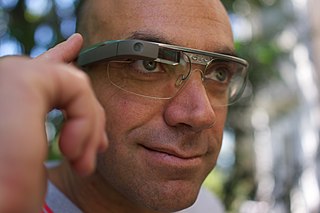
The Virtual Boy is a 32-bit table-top video game console developed and manufactured by Nintendo. Released in 1995 it was marketed as the first console capable of displaying stereoscopic "3D" graphics. The player uses the console like a head-mounted display, placing their head against the eyepiece to see a red monochrome display. The games use a parallax effect to create the illusion of depth. Sales failed to meet targets, and by early 1996, Nintendo ceased distribution and game development, releasing only 22 games for the system.

A hologram is a physical structure that uses light diffraction to make an image; the image can appear to be three-dimensional. Holography is the science and practice of making holograms. Typically, a hologram is a photographic recording of a light field, rather than an image formed by a lens. The holographic medium, i.e., the object produced by a holographic process is usually unintelligible when viewed under diffuse ambient light. It is an encoding of the light field as an interference pattern of variations in the opacity, density, or surface profile of the photographic medium. When suitably lit, the interference pattern diffracts the light into an accurate reproduction of the original light field, and the objects that were in it exhibit visual depth cues such as parallax and perspective that change realistically with the relative position of the observer. That is, the view of the image from different angles represents the subject viewed from similar angles.

Stereoscopy is a technique for creating or enhancing the illusion of depth in an image by means of stereopsis for binocular vision. The word stereoscopy derives from Greek στερεός (stereos), meaning 'firm, solid', and σκοπέω (skopeō), meaning 'to look, to see'. Any stereoscopic image is called a stereogram. Originally, stereogram referred to a pair of stereo images which could be viewed using a stereoscope.
A stereo display is a display device capable of conveying depth perception to the viewer by means of stereopsis for binocular vision.

In-Q-Tel (IQT), formerly Peleus and known as In-Q-It, is an American not-for-profit venture capital firm based in Arlington, Virginia. It invests in high-tech companies for the sole purpose of keeping the Central Intelligence Agency, and other intelligence agencies, equipped with the latest in information technology in support of United States intelligence capability. The name, "In-Q-Tel" is an intentional reference to Q, the fictional inventor who supplies technology to James Bond.
A volumetric display device is a graphic display device that forms a visual representation of an object in three physical dimensions, as opposed to the planar image of traditional screens that simulate depth through a number of different visual effects. One definition offered by pioneers in the field is that volumetric displays create 3D imagery via the emission, scattering, or relaying of illumination from well-defined regions in (x,y,z) space.

A head-mounted display (HMD) is a display device, worn on the head or as part of a helmet, that has a small display optic in front of one or each eye. A HMD has many uses, including in gaming, aviation, engineering, and medicine lift. A head-mounted display is the primary component of virtual reality headsets. There is also an optical head-mounted display (OHMD), which is a wearable display that can reflect projected images and allows a user to see through it.

The Holographic Versatile Disc (HVD) is an optical disc technology developed between April 2004 and mid-2008 that can store up to several terabytes of data on an optical disc 10 cm or 12 cm in diameter. The reduced radius reduces cost and materials used. It employs a technique known as collinear holography, whereby a green and red laser beam are collimated in a single beam. The green laser reads data encoded as laser interference fringes from a holographic layer near the top of the disc. A red laser is used as the reference beam to read servoinformation from a regular CD-style aluminium layer near the bottom. Servoinformation is used to monitor the position of the read head over the disc, similar to the head, track, and sector information on a conventional hard disk drive. On a CD or DVD this servoinformation is interspersed among the data. A dichroic mirror layer between the holographic data and the servo data reflects the green laser while letting the red laser pass through. This prevents interference from refraction of the green laser off the servo data pits and is an advance over past holographic storage media, which either experienced too much interference, or lacked the servo data entirely, making them incompatible with current CD and DVD drive technology.
No longer active as of Spring 2004, the Spatial Imaging Group at the MIT Media Lab developed new technology and interfaces for high-quality 3D displays.

Autostereoscopy is any method of displaying stereoscopic images without the use of special headgear or glasses on the part of the viewer. Because headgear is not required, it is also called "glasses-free 3D" or "glassesless 3D". There are two broad approaches currently used to accommodate motion parallax and wider viewing angles: eye-tracking, and multiple views so that the display does not need to sense where the viewers' eyes are located.
Holographic data storage is a potential technology in the area of high-capacity data storage currently dominated by magnetic data storage and conventional optical data storage. Magnetic and optical data storage devices rely on individual bits being stored as distinct magnetic or optical changes on the surface of the recording medium. Holographic data storage records information throughout the volume of the medium and is capable of recording multiple images in the same area utilizing light at different angles.

Kristina M. Johnson is an American business executive, engineer, academic, and former government official, and 13th Chancellor of the State University of New York. She has been a leader in the development of optoelectronic processing systems, 3-D imaging, and color-management systems.

A parallax barrier is a device placed in front of an image source, such as a liquid crystal display, to allow it to show a stereoscopic or multiscopic image without the need for the viewer to wear 3D glasses. Placed in front of the normal LCD, it consists of an opaque layer with a series of precisely spaced slits, allowing each eye to see a different set of pixels, so creating a sense of depth through parallax in an effect similar to what lenticular printing produces for printed products and lenticular lenses for other displays. A disadvantage of the method in its simplest form is that the viewer must be positioned in a well-defined spot to experience the 3D effect. However, recent versions of this technology have addressed this issue by using face-tracking to adjust the relative positions of the pixels and barrier slits according to the location of the user's eyes, allowing the user to experience the 3D from a wide range of positions. Another disadvantage is that the horizontal pixel count viewable by each eye is halved, reducing the overall horizontal resolution of the image.
WOWvx is a type of monitor screen and software tools manufactured by Philips and other companies that offers 3D images without glasses for several viewers at a time. A range of professional 3D displays for the advertising, entertainment and 3D visualization are available. WOWvx uses the 3D format called 2D-plus-depth that has a greyscale depth map next to each 2D frame.
A holographic display is a type of display that utilizes light diffraction to create a virtual three-dimensional image of an object. Holographic displays are distinguished from other forms of 3D imaging in that they do not require the aid of any special glasses or external equipment for a viewer to see the image.

Zebra Imaging was a company that developed 3D digital holographic images, hologram imagers and interactive 3D displays for government and commercial uses. The company offers digital holograms that are autostereoscopic, full-parallax and in monochrome or full-color. They have also developed a 3D Dynamic Display, which is capable of rendering holograms in real time. To a layperson, this means that design work with 3D programs such as SketchUp and 123D Catch can be viewed on a holographic display while they are actively being edited.

The Japan 2022 FIFA World Cup bid is the second official bid from the Japan Football Association or the JFA. Had this bid been successful, Japan would have been hosting their second World Cup Finals and it would have been their first solo hosting since they shared the 2002 FIFA World Cup with other co-host South Korea, becoming the sixth nation to host the tournament twice, after Italy, France, Mexico, Brazil and (West) Germany. On May 4, 2010, the Japanese Football Association Bid team decided to concentrate solely on winning the right to host the 2022 FIFA World Cup..
Holoxica Limited is a hard tech company working on disruptive holographic 3D technologies, from static digital holograms to dynamic holographic video displays. Holographic technology is based on the physical principles of light diffraction and does not require glasses or wearables, where images can appear in mid-air and are viewable naturally. The company started by making static 3D digital holographic images for medical imaging, scientific data visualization, engineering design and architecture. Holoxica has also pioneered a series of dynamically changeable holographic displays over the past few years. The company is located at Codebase, Edinburgh, Scotland, the largest technology incubator in the UK.

An optical head-mounted display (OHMD) is a wearable device that has the capability of reflecting projected images as well as allowing the user to see through it, similar to augmented reality technology. OHMD technology has existed since 1997 in various forms, but despite a number of attempts from industry, has yet to be commercialised.

WayRay is a technology company with offices in Switzerland, United States, China, Hong Kong, Germany, and Russia. It develops holographic AR technologies for connected cars. WayRay's in-house R&D center and prototyping facilities create holographic optical systems, complex mechanics, electronics, and software.

















